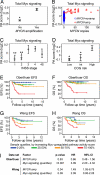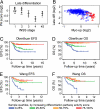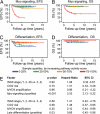High Myc pathway activity and low stage of neuronal differentiation associate with poor outcome in neuroblastoma
- PMID: 18780787
- PMCID: PMC2544584
- DOI: 10.1073/pnas.0804455105
High Myc pathway activity and low stage of neuronal differentiation associate with poor outcome in neuroblastoma
Abstract
The childhood cancer neuroblastoma arises in the developing sympathetic nervous system and is a genotypically and phenotypically heterogeneous disease. Prognostic markers of poor survival probability include amplification of the MYCN oncogene and an undifferentiated morphology. Whereas these features discriminate high- from low-risk patients with precision, identification of poor outcome low- and intermediate-risk patients is more challenging. In this study, we analyze two large neuroblastoma microarray datasets using a priori-defined gene expression signatures. We show that differential overexpression of Myc transcriptional targets and low expression of genes involved in sympathetic neuronal differentiation predicts relapse and death from disease. This was evident not only for high-risk patients but was also robust in identifying groups of poor prognosis patients who were otherwise judged to be at low- or intermediate-risk for adverse outcome. These data suggest that pathway-specific gene expression profiling might be useful in the clinic to adjust treatment strategies for children with neuroblastoma.
Conflict of interest statement
The authors declare no conflict of interest.
Figures





Similar articles
-
Incorporating genomic, transcriptomic and clinical data: a prognostic and stem cell-like MYC and PRC imbalance in high-risk neuroblastoma.BMC Syst Biol. 2017 Oct 3;11(Suppl 5):92. doi: 10.1186/s12918-017-0466-5. BMC Syst Biol. 2017. PMID: 28984200 Free PMC article.
-
Transcript signatures that predict outcome and identify targetable pathways in MYCN-amplified neuroblastoma.Mol Oncol. 2016 Nov;10(9):1461-1472. doi: 10.1016/j.molonc.2016.07.012. Epub 2016 Aug 18. Mol Oncol. 2016. PMID: 27599694 Free PMC article.
-
MYCN protein expression as a predictor of neuroblastoma prognosis.Clin Cancer Res. 1997 Oct;3(10):1699-706. Clin Cancer Res. 1997. PMID: 9815553
-
N-myc and noncoding RNAs in neuroblastoma.Mol Cancer Res. 2012 Oct;10(10):1243-53. doi: 10.1158/1541-7786.MCR-12-0244. Epub 2012 Aug 30. Mol Cancer Res. 2012. PMID: 22936790 Review.
-
Cross-study analysis of gene expression data for intermediate neuroblastoma identifies two biological subtypes.BMC Cancer. 2007 May 25;7:89. doi: 10.1186/1471-2407-7-89. BMC Cancer. 2007. PMID: 17531100 Free PMC article. Review.
Cited by
-
Functional MYCN signature predicts outcome of neuroblastoma irrespective of MYCN amplification.Proc Natl Acad Sci U S A. 2012 Nov 20;109(47):19190-5. doi: 10.1073/pnas.1208215109. Epub 2012 Oct 22. Proc Natl Acad Sci U S A. 2012. PMID: 23091029 Free PMC article.
-
MYCN mediates TFRC-dependent ferroptosis and reveals vulnerabilities in neuroblastoma.Cell Death Dis. 2021 May 19;12(6):511. doi: 10.1038/s41419-021-03790-w. Cell Death Dis. 2021. PMID: 34011924 Free PMC article.
-
Deubiquitinating activity of CYLD is impaired by SUMOylation in neuroblastoma cells.Oncogene. 2015 Apr 23;34(17):2251-60. doi: 10.1038/onc.2014.159. Epub 2014 Jun 9. Oncogene. 2015. PMID: 24909169
-
cMyc Regulates the Size of the Premigratory Neural Crest Stem Cell Pool.Cell Rep. 2016 Dec 6;17(10):2648-2659. doi: 10.1016/j.celrep.2016.11.025. Cell Rep. 2016. PMID: 27926868 Free PMC article.
-
HOXD-AS1 is a novel lncRNA encoded in HOXD cluster and a marker of neuroblastoma progression revealed via integrative analysis of noncoding transcriptome.BMC Genomics. 2014;15 Suppl 9(Suppl 9):S7. doi: 10.1186/1471-2164-15-S9-S7. Epub 2014 Dec 8. BMC Genomics. 2014. PMID: 25522241 Free PMC article.
References
-
- Brodeur GM, Maris JM. In: Principles and Practice of Pediatric Oncology. Pizzo PA, Poplack DG, editors. Philadelphia: JB Lippincott; 2006. pp. 933–970.
-
- Hoehner JC, et al. A developmental model of neuroblastoma: differentiating stroma-poor tumors' progress along an extra-adrenal chromaffin lineage. Lab Invest. 1996;75:659–675. - PubMed
-
- Hoehner JC, et al. Developmental gene expression of sympathetic nervous system tumors reflects their histogenesis. Lab Invest. 1998;78:29–45. - PubMed
-
- Brodeur GM. Neuroblastoma: Biological insights into a clinical enigma. Nat Rev Cancer. 2003;3:203–216. - PubMed
Publication types
MeSH terms
Substances
Grants and funding
LinkOut - more resources
Full Text Sources
Medical

